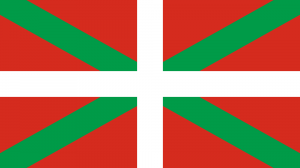Difference between revisions of "Language/Basque/Grammar/Basic-Sentence-Structure"
m (Quick edit) |
m (Quick edit) |
||
| Line 1: | Line 1: | ||
<span pgnav> | |||
{| class="wikitable pg_template_nav" | |||
|[[Language/Basque/Grammar/Alphabet-and-Pronunciation|◀️ Alphabet and Pronunciation — Previous Lesson]] | |||
|[[Language/Basque/Vocabulary/Common-Greetings|Next Lesson — Common Greetings ▶️]] | |||
|} | |||
</span> | |||
{{Basque-Page-Top}} | {{Basque-Page-Top}} | ||
| Line 98: | Line 105: | ||
{{Basque-Page-Bottom}} | {{Basque-Page-Bottom}} | ||
<span pgnav> | |||
{| class="wikitable pg_template_nav" | |||
|[[Language/Basque/Grammar/Alphabet-and-Pronunciation|◀️ Alphabet and Pronunciation — Previous Lesson]] | |||
|[[Language/Basque/Vocabulary/Common-Greetings|Next Lesson — Common Greetings ▶️]] | |||
|} | |||
</span> | |||
Revision as of 22:39, 2 April 2023
| ◀️ Alphabet and Pronunciation — Previous Lesson | Next Lesson — Common Greetings ▶️ |
Basque is a unique and fascinating language that has been spoken in the Basque Country for thousands of years. In this lesson, we will explore the basic sentence structure in Basque, including the order of subject, verb, and object.
Basque is an ergative language, which means that the subject of a transitive verb takes the same case marking as the object of an intransitive verb. In addition, Basque makes use of postpositions rather than prepositions, which means that the postposition comes after the noun or pronoun it modifies.
Word Order
In Basque, the order of subject, verb, and object is flexible. However, the most common word order is subject-verb-object (SVO). For example:
- Gizona etxea ikusi du. (The man has seen the house.)
- Lorea etxera ekarri du. (She has brought the flower home.)
It is also possible in Basque to have object-subject-verb (OSV) word order, especially for emphasis:
- Etxea ikusi du gizona. (The man has seen the house.)
- Ekarri du lorea etxera. (She has brought the flower home.)
Dative Case
Basque also has a dative case, which is used to indicate the recipient of an action. The dative case is formed by adding the suffix '-ri' to the noun or pronoun. For example:
- Liburu hau niri ematen ditut. (They are giving me this book.)
- Idazki hori zuri bidaliko diat. (I will send that letter to you.)
In the second example, you can see that the dative case is used with the postposition '-ri'.
Negation
To make a negative sentence in Basque, the word 'ez' is placed before the verb. For example:
- Ez dut liburua irakurri. (I have not read the book.)
- Ez du ezer erosi. (She has not bought anything.)
Questions
In Basque, questions are formed by simply raising the intonation at the end of a sentence, without any change in word order. For example:
- Etxea ikusi du gizona? (Has the man seen the house?)
- Ekarri du lorea etxera? (Has she brought the flower home?)
In addition, you can use question words to form more complex questions. Some common question words in Basque are:
- Nork? (Who?)
- Zer? (What?)
- Noiz? (When?)
- Non? (Where?)
- Nola? (How?)
For example:
- Nongoa zara? (Where are you from?)
- Zer da hori? (What is that?)
Recap
In this lesson, we have learned about the basic sentence structure in Basque, including the order of subject, verb, and object. We have also looked at the dative case, negation, and forming questions in Basque. As you continue to study the language, you will become more comfortable with these concepts and be able to form more complex sentences.
Other Lessons
- Common Prepositions
- Past Participle in Basque
- Interrogative Words
- Future Tense
- Present Tense
- Definite Articles in Basque
- Conditional Mood
- Pronouns
- How to Use Be
- 0 to A1 Course
Sources
- Basque grammar - Wikipedia
- A Brief Grammar of Euskara, the Basque Language
- Language/Basque/Grammar/0-to-A1-Course
| ◀️ Alphabet and Pronunciation — Previous Lesson | Next Lesson — Common Greetings ▶️ |
